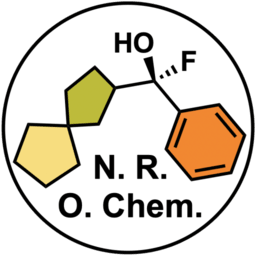Reactions to a Carbonyl
This post is about reactions happening to the carbonyl group of a given molecule, including but not limited to compounds such as aldehydes, ketones, carboxylic acids, esters, amides, enones, acyl halides, acid anhydrides, and imides. The post is active and growing, so you can expect more examples to be added over time. Please be sure to come back. The updates will be announced on my instagram account.
Last update 22/12/10.
Table of Contents
1,2-Additions
Organic reactions where a nucleophile adds to the carbonyl carbon of a substrate to form a larger molecule.
9. For the synthesis of Gymnothelignan N.
A diastereoselective aldol addition of the chlorotitanium enolate of thiazolidinethione propionate with 5-methoxypiperonal afforded the desired syn-aldol adduct in 97% yield.
8. For the synthesis of Iezoside.
The tertiary allylic alcohol was synthesized from the Weinreb amide via two consecutive Grignard reactions using methyl magnesium bromide and vinyl magnesium bromide, respectively.
7. For the synthesis of Norzoanthamine.
A hydroxymethyl group was introduced at the alpha position of the ketone through a base-mediated aldol reaction, leading to the formation of the compound on the upper right.
A second hydroxymethyl group was introduced via a Baylis-Hillman reaction.
6. For the synthesis of Euonymine.
A Baylis-Hillman reaction.
5. For the synthesis of Dysiherbol A.
Cerium chloride is a Lewis acid and thus has a high affinity for oxygen atoms. This makes it an effective additive for 1,2-additions, where the Ce3+ ion coordinates to the oxygen atom of the carbonyl group and activates it toward nucleophilic attack.
Angew. Chem. Int. Ed. 2021, 60, 14915. Open access.
4. For the synthesis of Curcusone A.
Owing to their oxophilicity, the authors tried to carry out this transformation in the presence of additives such as cerium chloride and lanthanum chloride, which have been used to promote 1,2-additions (see reaction above, entry #5). Unfortunately, both failed. Eventually, the 1,2-addition was improved by increasing the amount of the lithiated ethyl vinyl ether to 10 equivalents, and the crude product was carried forward to the next step without further purification.
3. For the synthesis of Curcusone A.
A Mukaiyama aldol addition: a Lewis acid-catalyzed aldol addition that uses a silyl enol ether as an enolate equivalent. First, formation of the extended silyl enol ether followed by the nucleophilic addition to the electrophile species generated in situ from ethyl orthoformate.
2. For the synthesis of Codonopiloneolignanin A.
A Grignard addition reaction.
1. For the synthesis of Annotinolide C.
J. Am. Chem. Soc. 2021, 143, 11951. Open access.
1,4-Additions
Organic reactions where a nucleophile adds at the C-4 atom of an enone to form the 1,4-adduct. Also called conjugate additions.
4. For the synthesis of Heilonine.
A Robinson annulation. Conjugate addition (Michael addition) followed by an intramolecular aldol condensation.
J. Am. Chem. Soc. 2021, 143, 16394. Open access.
3. For the synthesis of Euphorikanin A.
Conjugate addition (Me2CuLi) followed by aldol addition of the intermediate enolate with the aldehyde. Copper iodide is often used to mediate conjugate addition reactions.
2. For the synthesis of Annotinolide C.
Nagata hydrocyanation. Named after Japanese chemist Kenkichi Nagata, this reaction involves the addition of hydrogen cyanide (HCN) to an unsaturated organic compound in the presence of a metal catalyst.
J. Am. Chem. Soc. 2021, 143, 11951. Open access.
1. For the synthesis of Curindolizine.
Umpolung reaction, where the carbonyl carbon becomes a nucleophile in a 1,4-addition. A stable carbanion was made using NaHMDS in the presence of LiCl; this species was added to the alpha,beta-unsaturated ketone, giving a 64% yield of the coupled product after quenching with N-iodosuccinimide.
Acylation and Alkylation
Acylation and Alkylation reactions. Excluded those in the alpha position of a carbonyl compound (vide infra).
1. For the synthesis of Peficitinib.
When the substrate was reacted with sec-BuLi, the TIPS protecting group was critical to block C-2, directing lithiation to C-5. An ethyl chloroformate quench yielded the desired C-5-substituted ethyl ester, which was deprotected with TBAF to provide the desired azaindole.
Alpha Alkylation
Alkylation reactions that take place at the alpha position of a carbonyl compound. Some acylation reactions also included.
7. For the synthesis of Incargranine A.
α-Acylation of the lactam was carried out using sodium bis(trimethylsilyl)amide (NaHMDS) and diethyl carbonate.
Angew. Chem. Int. Ed. 2023, e202314308. Open access.
6. For the synthesis of Cephalotaxus Alkaloids.
The KOtBu mediated Dieckmann ring closure yielded the tetracyclic system. In situ etherification of the enolate intermediate with dimethyl sulfate afforded the depicted product.
5. For the synthesis of Annotinolide C.
An acylation reaction.
J. Am. Chem. Soc. 2021, 143, 11951. Open access.
4. For the synthesis of Pladienolide B.
The unprotected epoxide was exposed to the dienolate derived from tert-butyl acetoacetate followed by acetic anhydride to form the product of epoxide ring opening in 86% yield.
3. For the synthesis of Euphorikanin A.
Alkylation of the ketone employing LiN(SiMe3)2 and chloro dithiane afforded the product in 90% yield as a single diastereomer. Cleavage of the dithiane was achieved by treatment of the substrate with PIFA in aqueous acetonitrile, giving the aldehyde in excellent yield (95%).
2. For the synthesis of Arborisidine.
Mannich reaction with the Eschenmoser salt and subsequent elimination to install the methyl group.
1. For the synthesis of Curcusone B.
α-methylation of the enone at C2 position.
Other Reactions
4. For the synthesis of Metaphanine.
First, the coupling reaction of TMS cyanohydrin and the mesylate was carried out with LiHMDS followed by treatment with TBAF to give the ketone in 78% yield.
3. For the synthesis of Heilonine.
Seyferth-Gilbert homologation through the use of the Bestmann-Ohira reagent.
J. Am. Chem. Soc. 2021, 143, 16394. Open access.
2. For the synthesis of Dysiherbol A.
The ketone was converted into the enol triflate by treatment with LDA and N-phenyl triflimide.
Angew. Chem. Int. Ed. 2021, 60, 14915. Open access.
1. For the synthesis of (S)-Cularine.
Ellman’s Sulfinamide.




























0 Comments